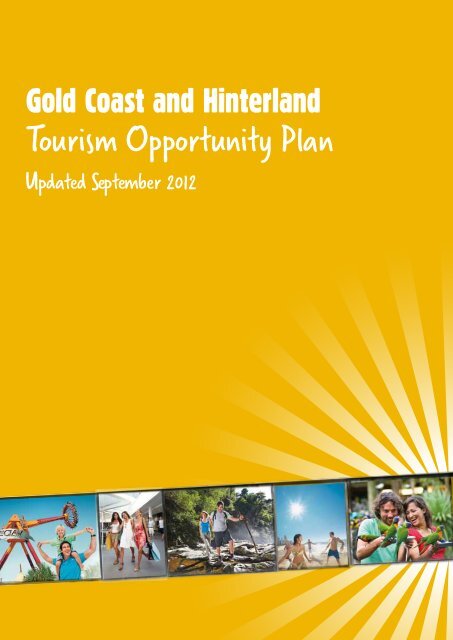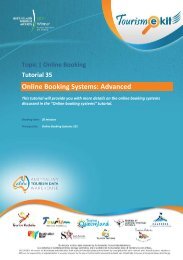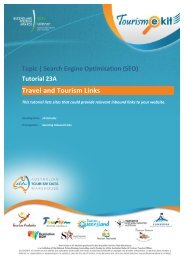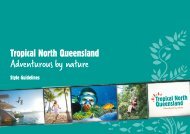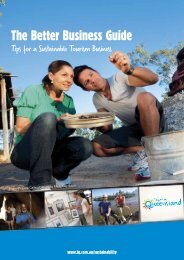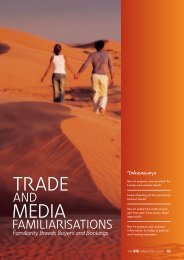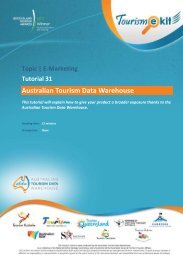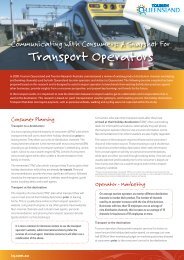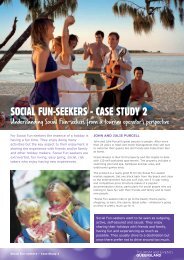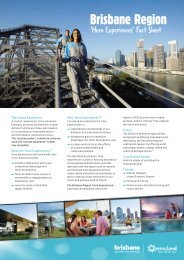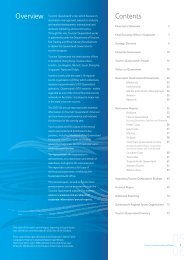Tourism Opportunity Plan - Tourism Queensland
Tourism Opportunity Plan - Tourism Queensland
Tourism Opportunity Plan - Tourism Queensland
You also want an ePaper? Increase the reach of your titles
YUMPU automatically turns print PDFs into web optimized ePapers that Google loves.
Gold Coast and Hinterland<br />
<strong>Tourism</strong> <strong>Opportunity</strong> <strong>Plan</strong><br />
Updated September 2012
DISCLAIMER – The <strong>Queensland</strong> Government makes no claim as to the<br />
accuracy of the information contained in the Gold Coast and Hinterland<br />
<strong>Tourism</strong> <strong>Opportunity</strong> <strong>Plan</strong> update. The document is not a prospectus and<br />
the information provided is general in nature. The document should not be<br />
relied upon as the basis for financial and investment related decisions. This<br />
document does not suggest or imply that the <strong>Queensland</strong> State Government<br />
or any other government, agency, organisation or person should be<br />
responsible for funding any projects or initiatives identified in this document.
Contents<br />
Surfers Paradise Aerial<br />
Acronyms ........................................................II<br />
1 Context. ..................................................... 1<br />
1.1 Purpose – What is a <strong>Tourism</strong> <strong>Opportunity</strong> <strong>Plan</strong>? ...........1<br />
1.2 Current <strong>Tourism</strong> Environment ..............................1<br />
2 Guiding Principles .......................................... 3<br />
2.1 TOP Development Methodology ...........................3<br />
2.2 Key Success Factors .......................................3<br />
Contents<br />
3 Our Vision. ................................................. 5<br />
3.1 The Region ..................................................5<br />
3.2 How has tourism in the region changed? ..................5<br />
3.3 What is the current tourism profile of the region? ..........6<br />
3.4 Target markets .............................................6<br />
3.5 The Gold Coast Visitor Market in 2020 – trends and<br />
forecasts ....................................................7<br />
4 Gap Analysis<br />
4.1 Destination Opportunities and Challenges ................9<br />
5 Catalyst Projects. .......................................... 10<br />
6 Supporting Projects. . . . . . . . . . . . . . . . . . . . . . . . . . . . . . . . . . . . . . . . .11<br />
7 Implementation. ............................................12<br />
Appendix. .......................................................13<br />
Table 2: Catalyst Projects .......................................13<br />
Table 3: Supporting Projects ....................................16<br />
i
Acronyms<br />
Green Challenge Course, Currumbin Wildlife Sanctuary<br />
ATEC<br />
GCCC<br />
GCCEC<br />
GCT<br />
Australian <strong>Tourism</strong> Export Council<br />
Gold Coast City Council<br />
Gold Coast Convention and Exhibition Centre<br />
Gold Coast <strong>Tourism</strong><br />
Acronyms<br />
GCWA Gold Coast Waterways Authority<br />
GOLDOC Gold Coast 2018 Commonwealth Games Corporation<br />
DNPRSR Department of National Parks, Recreation, Sport and Racing<br />
QPWS<br />
OUM<br />
TEQ<br />
TOP<br />
<strong>Queensland</strong> Parks and Wildlife Service<br />
Office of Urban Management<br />
<strong>Tourism</strong> and Events <strong>Queensland</strong><br />
<strong>Tourism</strong> <strong>Opportunity</strong> <strong>Plan</strong><br />
ii
1 Context<br />
Gold Coast Dining, Marina Mirage<br />
1.1 Purpose – What is a <strong>Tourism</strong><br />
<strong>Opportunity</strong> <strong>Plan</strong>?<br />
The Purpose of the Gold Coast and Hinterland <strong>Tourism</strong> <strong>Opportunity</strong><br />
<strong>Plan</strong> (TOP) is to provide direction for the sustainable development of<br />
tourism in the Gold Coast region.<br />
This document is an update of the Gold Coast and Hinterland<br />
<strong>Tourism</strong> <strong>Opportunity</strong> <strong>Plan</strong> 2009 – 2018 reflecting that since the<br />
inception of this document in 2008, the tourism environment on the<br />
Gold Coast has changed.<br />
The projects and opportunities identified in the 2008 TOP were<br />
determined in a very different tourism environment. The purpose<br />
of updating the Gold Coast TOP is to refocus the direction for the<br />
sustainable development of tourism in the region to 2020.<br />
Since the original Gold Coast TOP was developed in 2008, a<br />
number of key deliverables for the project have also been met, while<br />
others need to be reviewed and prioritised. It is anticipated that<br />
this updated document will provide a renewed and reinvigorated<br />
direction for the sustainable development of tourism in the Gold<br />
Coast region.<br />
The Gold Coast and Hinterland TOP update will:<br />
Re-prioritise the identification of new and upgraded tourism<br />
product that meets visitor expectations and demands;<br />
Re-prioritise the need for new investment in infrastructure that<br />
supports the ongoing development of tourism;<br />
Re-prioritise relevant research based information on tourism<br />
supply and demand;<br />
Provide a renewed focus and reinvigorate engagement with the<br />
tourism industry, infrastructure providers and private investors;<br />
and support the vision of the Gold Coast as outlined in the Gold<br />
Coast Destination <strong>Tourism</strong> Strategy.<br />
1.2 Current <strong>Tourism</strong> Environment<br />
The <strong>Queensland</strong> Government held the inaugural DestinationQ<br />
forum in Cairns on 25 and 26 June 2012. The forum provided an<br />
opportunity for more than 300 tourism industry representatives to<br />
contribute to the policy direction of the <strong>Queensland</strong> Government.<br />
The forum culminated in the development of a Partnership<br />
Agreement between industry and government. A key element of the<br />
Partnership Agreement included the recognition that both industry<br />
and government must work together cooperatively, and contribute<br />
jointly, to achieving the <strong>Tourism</strong> 2020 goals. This principle will<br />
also apply to the projects outlined in this TOP. This will require that<br />
industry, and federal, state and local governments all play a role in<br />
delivering these projects.<br />
The Gold Coast TOP is an adjunct to the Gold Coast Destination<br />
<strong>Tourism</strong> Strategy, which was released in 2012 and provides the<br />
framework to guide tourism industry development in the Gold Coast<br />
by coordinating stakeholders in a common direction to maximise<br />
the tourism potential of the destination. The TOP’s role as part of<br />
this framework is to act as a guide to government, industry and<br />
stakeholders as to projects and action steps the industry believes<br />
are required, for the most effective impacts on tourism.<br />
In addition to stakeholder feedback since the release of the original<br />
TOP in 2008, the updated TOP is based on extensive research<br />
as well as consultation with a range of regional and external<br />
stakeholders including government agencies, tourism industry,<br />
external tourism stakeholders, developers and investors.<br />
The updated Gold Coast TOP does not assert to canvass all possible<br />
projects for the region but instead makes recommendations based<br />
on the catalyst projects identified in the original plan and which fulfil<br />
the destination objectives, have strong stakeholder support and<br />
are likely to assist in realising the destination’s long term vision for<br />
sustainable tourism.<br />
The TOP does not imply endorsement by local, state or federal<br />
governments, nor does it imply funding commitments. The TOP<br />
is a list of the key catalyst projects developed by industry with the<br />
assistance of government, to guide the planning and development<br />
of projects that offer the tourism industry the best available<br />
opportunities for growth.<br />
For the purposes of this project, the Gold Coast region is defined by<br />
the Gold Coast City Council boundaries which includes 47 Statistical<br />
Local Areas (SLAs) extending from Beenleigh in the North,<br />
Coolangatta in the South and Lower Beechmont and Springbrook in<br />
the West. The Gold Coast contains a number of nodes or precincts<br />
of tourism activity or high levels of visitation.<br />
1 Context<br />
1
Figure 1: Map of The Gold Coast Region<br />
NORTHERN TERRITORY<br />
SOUTH<br />
AUSTRALIA<br />
GOLD COAST CITY<br />
NEW SOUTH WALES<br />
1 Context<br />
DARWIN<br />
G R E A T B A R R I E R R E<br />
CAIRNS<br />
E F<br />
PERTH<br />
AUSTRALIA<br />
CANBERRA<br />
ADELAIDE<br />
MELBOURNE<br />
SYDNEY<br />
BRISBANE<br />
HOBART<br />
Metricon Stadium, Carrara<br />
2
2 Guiding Principles<br />
Skypoint<br />
Q1, Surfers Paradise<br />
2.1 TOP Development Methodology<br />
The methodology undertaken to develop the Gold Coast and<br />
Hinterland TOP in 2008 and subsequently this TOP update in 2012<br />
included the following key steps:<br />
Review of existing background research, reports and literature<br />
with relevance to tourism in the Region;<br />
Consultation with a wide range of stakeholders through oneon-one<br />
interviews, attending council meetings and hosting<br />
interactive stakeholder forums;<br />
Analysis of key tourism product gaps and opportunities for the<br />
Region;<br />
Prioritisation of tourism product opportunities against agreed<br />
criteria; and<br />
Review of proposed projects with key stakeholders to develop<br />
final plan.<br />
Stakeholders consulted throughout the project included<br />
representatives from:<br />
Federal Government<br />
State Government<br />
Local Government<br />
Regional <strong>Tourism</strong> Organisations<br />
<strong>Tourism</strong> Associations<br />
Local <strong>Tourism</strong> Organisations<br />
<strong>Tourism</strong> operators<br />
2.2 Key Success Factors<br />
For any destination strategy to be effective and sustainable in<br />
the long term, it must have strong foundations. As outlined in<br />
Figure 2, overleaf, there are three main foundations which act as<br />
cornerstones to a successful destination strategy:<br />
Market Demand characteristics (to meet the needs of consumer<br />
markets)<br />
The regions distinctive competence or competitive advantage<br />
The values and aspirations of the local community<br />
These are the broad guiding principles in updating the Gold Coast<br />
TOP and in terms of satisfying these principles consideration has<br />
been given to the following concepts:<br />
Target Market Aligned – does the project meet the needs of<br />
growth target markets for the region?<br />
Destination attributes – does the project capitalise on a<br />
particular destination attribute that would stimulate destination<br />
appeal and visitor interest?<br />
Regional Growth – does the project have the potential to<br />
stimulate growth in the region over the next 10 years?<br />
Value Added Experiences – does the development of new<br />
products complement rather than compete with existing<br />
products?<br />
Stakeholder Support – does the project have a strong level of<br />
interest from local stakeholders and is the project aligned with<br />
the vision for the region and community aspirations?<br />
Sustainability – do the likely net benefits of the project span<br />
across the social, environmental and/or economic outcomes for<br />
the region?<br />
Strategic Alignment – does the project align with Local, State<br />
or Federal Government priorities and is it likely to gain support<br />
from the decision makers?<br />
Based on the above considerations, the identified projects for<br />
this TOP update have been classified into one of the following<br />
categories:<br />
Catalyst Projects – There are the 9 catalyst projects identified<br />
for the Gold Coast and Hinterland region. These are tourism<br />
investment or infrastructure projects of regional significance<br />
and which are expected to act as catalysts to generate a range<br />
of other investment, marketing and product development<br />
opportunities.<br />
Supporting Projects – These region-wide projects are tourism<br />
infrastructure projects which address identified region<br />
wide issues and are expected to act as enablers for further<br />
investment and product development opportunities.<br />
2 Guiding Principles<br />
The overlap of these three fundamental areas serves as the central<br />
pillar of a successful destination strategy.<br />
3
Figure 2: Guiding Principles used in the development of the Gold Coast <strong>Tourism</strong> <strong>Opportunity</strong> <strong>Plan</strong><br />
Distinctiveness /<br />
Competitive Strengths<br />
Characteristics<br />
of Demand<br />
2 Guiding Principles<br />
Whatever is unique and<br />
unavailable in other destinations<br />
will be key input to positioning<br />
and branding<br />
The optimal development, investment<br />
and marketing strategy will represent<br />
the intersection and balance of the<br />
three main inputs shown<br />
Values of people<br />
who live and work<br />
in the place<br />
The values of the local<br />
community cannot be<br />
compromised<br />
Source: Valerio, P. and EC3 Global<br />
The shape and size of demand<br />
needs to be considered at the<br />
big picture level. The different types<br />
of demand also need to<br />
be considered.<br />
Jupiters Casino, Broadbeach<br />
4
3 Our Vision<br />
Surfers<br />
Paradise Foreshore<br />
To the holiday maker, the famous Gold Coast experience represents<br />
Australia at its best. The collective voice of more than 11 million<br />
visitors each year is a clear indication of the region’s ability to<br />
continually offer up new and innovative things to see and do all year<br />
long.<br />
3.1 The Region<br />
In considering the vision for the Gold Coast and Hinterland the<br />
below key attributes are critical to the success of the Gold Coast<br />
destination and future tourism development projects:<br />
Such strength lies in the natural and manmade diversity of a<br />
destination which is scenic and peaceful as much as it is fast paced<br />
and active.<br />
As defined in the Gold Coast Destination <strong>Tourism</strong> Strategy (GCDTS):<br />
Australia’s Gold Coast is a world class leisure and<br />
business travel destination. For generations the Gold<br />
Coast has been celebrated as Australia’s favourite<br />
holiday playground and today it is also popular with<br />
the business events travel sector who equally value<br />
the destination’s diverse natural environment and its<br />
unrivalled variety of built attractions. The Gold Coast<br />
experience is characterised by its beach culture, active<br />
lifestyle, entertainment options, nature based assets<br />
and themed attractions. The Gold Coast is a welcoming<br />
international tourist destination, attracting more than 11<br />
million leisure and business visitors each year.<br />
The vision in the Gold Coast and Hinterland Destination <strong>Tourism</strong><br />
Strategy is for the region to be:<br />
Globally recognised as a world-class leisure and<br />
business events destination famous for its unrivalled<br />
variety of entertainment, excitement and fun.<br />
As per the DTS, for the Gold Coast and Hinterland to achieve its<br />
aspiration for 2020 it is critical that there is:<br />
A co-ordinated approach to destination promotion and<br />
marketing<br />
Innovative product and infrastructure development across the<br />
region that delivers on the marketing promise; and<br />
A tourism industry that is operating at the highest standards<br />
of service, safety and sustainability through effective industry<br />
development programs.<br />
A variety of quality beaches;<br />
Warm and sunny weather;<br />
Good range of accommodation;<br />
Presence of internationally recognised hotel brands;<br />
Availability of internationally recognised adventure experiences;<br />
Strong national and international reputation as a leisure holiday<br />
destination;<br />
A burgeoning reputation as an important business events<br />
destination;<br />
Activities which cater to a variety of visitor demographics and<br />
niche markets;<br />
Non-adventure experiences e.g. art or sport; and<br />
World Heritage Rainforest.<br />
3.2 How has tourism in the region changed?<br />
Since the inception of the Gold Coast and Hinterland <strong>Tourism</strong><br />
<strong>Opportunity</strong> <strong>Plan</strong> (TOP) in 2008, the tourism environment on the<br />
Gold Coast has changed:<br />
The Global Financial Crisis has resulted in declines in visitation<br />
from a number of source countries, with these global issues<br />
being exacerbated by the 2011 natural disasters in New<br />
Zealand and Japan (the Gold Coast’s largest and third largest<br />
international source markets respectively).<br />
The Chinese visitor market to the Gold Coast has grown by 20%<br />
since 2008, supported by an increase in airline services from<br />
China to South East <strong>Queensland</strong>.*<br />
New infrastructure, including the development of three new five<br />
star accommodation offerings has provided the region with a<br />
wider range of tourism offerings.<br />
Domestic visitation to the Gold Coast has been subdued due<br />
largely to the strength of the Australian dollar driving demand<br />
for outbound travel.*<br />
3 Our Vision<br />
*Data sources: National & International Visitor Surveys, <strong>Tourism</strong> Research Australia.<br />
5
3 Our Vision<br />
The Gold Coast has celebrated winning the prestigious and<br />
high profile 2018 Commonwealth Games, which will provide<br />
significant opportunities to shape infrastructure needs<br />
The Gold Coast, Famous for fun brand was introduced to<br />
replace the Very GC positioning. The brand captures the<br />
essence of the Gold Coast as the place where you go on<br />
holidays to have fun and the new brand positions the Gold<br />
Coast as Australia’s endless playground offering the best<br />
Australia has to offer in the realm of excitement, energy, play<br />
and fun.<br />
3.3 What is the current tourism profile of<br />
the region?<br />
The projects and opportunities identified in the 2008 TOP were<br />
based on forecasted growth rates determined at the time of<br />
publication. Since the original Gold Coast TOP was developed, the<br />
Gold Coast, like all destinations in Australia, has been exposed to a<br />
number of factors mitigating against the growth forecasted in 2008.<br />
In 2011, the Gold Coast experienced the following tourism trends*:<br />
Domestic visitation to the Gold Coast softened in 2011, driven<br />
by declines in holiday and VFR (visiting friends or relatives)<br />
travel. In contrast to this, domestic business travel continued to<br />
increase, up 7% in 2011.<br />
Interstate visitation declined in 2011, with travel from Sydney and<br />
Melbourne decreasing, as was the case state-wide. This was<br />
partially offset by a welcome increase in travel from regional<br />
New South Wales (NSW), which is now the Gold Coast’s largest<br />
interstate source market.<br />
Intrastate visitation eased by 2% in 2011, highlighting the low<br />
consumer confidence that exists in the marketplace. Solid<br />
growth in intrastate VFR travel to the Gold Coast further<br />
exemplifies the budget conscious decision making process of<br />
domestic travellers.<br />
Three of the region’s key source markets –New Zealand (NZ),<br />
Japan and the United Kingdom (UK) all recorded visitor declines.<br />
The natural disasters in NZ and Japan impacted outbound<br />
holiday travel to <strong>Queensland</strong>, with the Gold Coast particularly<br />
impacted. The European financial crisis and subsequent high<br />
youth (under 30 years) unemployment softened travel from the<br />
UK.<br />
Previous growth from China slowed, possibly the result of direct<br />
flights into Brisbane now being established for over a year.<br />
Chinese visitation is however, up 20% since 2008. This has<br />
seen China become the second largest international source<br />
market for the Gold Coast.<br />
Despite the declines in domestic visitation to the Gold Coast,<br />
the average length of stay of these travellers remained stable.<br />
Growth was seen in the length of stay of VFR travellers (up 0.4<br />
nights to 3.5 nights).<br />
The average length of stay of international visitors to the Gold<br />
Coast increased, with growth recorded in holiday, VFR and<br />
business travel.<br />
In addition there are a number of consumer and market trends that<br />
are likely to influence the future development of tourism in the<br />
region:<br />
Global Consumer Trends<br />
Increasing use of the internet and social networking<br />
Improved access and affordability of air travel<br />
Value for money is critically important<br />
Destination ‘brag-ability’ is increasingly important<br />
Visitors seeking more ‘meaningful’ experiences<br />
Growth in ‘voluntourism’, community oriented-tourism and ‘offthe-beaten<br />
track’ travel<br />
Australian Market Trends<br />
How you feel is more important than how old you are – the<br />
emergence of ‘psychographic’ segmentation<br />
The ‘Experience Seekers’ are looking for learning experiences<br />
Visitors are seeking authentic interactions with locals, nature<br />
and destinations<br />
<strong>Queensland</strong> Market Trends<br />
Visitors are seeking natural encounters, islands and beaches,<br />
<strong>Queensland</strong> lifestyle, and adventure<br />
Visitors want fun, relaxing and care-free experiences and to<br />
escape the crowds<br />
An industry shift towards experience segmentation – targeting<br />
visitor needs and wants<br />
3.4 Target markets<br />
Traditional methods of market research have defined consumers<br />
by demographic and life-stage variables that assume everyone in<br />
the same age group or with the same income act in a similar way.<br />
In order to better understand the consumers’ needs and wants,<br />
maximise the impact of the development, the marketing dollar and<br />
to communicate more effectively with the consumer, <strong>Tourism</strong> and<br />
Events <strong>Queensland</strong> has adopted a needs-based segmentation<br />
approach for identifying both domestic and international target<br />
markets. This approach is similar to the experience-based<br />
segmentation adopted by <strong>Tourism</strong> Australia for targeting<br />
international markets<br />
All tourism development and promotion activity is based on<br />
consumer needs. The following target markets for the Gold Coast<br />
include the current targets and those identified for development to<br />
achieve the region’s long term appeal.<br />
Tier One:<br />
■■<br />
■■<br />
■■<br />
Connectors in Brisbane and Regional <strong>Queensland</strong><br />
Social Fun Seekers in Sydney and Melbourne<br />
New Zealand, United Kingdom, China, Taiwan, Hong Kong,<br />
Japan, Middle East, Singapore, Malaysia and Indonesia<br />
Tier Two:<br />
■■<br />
North America, Germany, France, Netherlands, Switzerland,<br />
India and Korea.<br />
*Data sources: National & International Visitor Surveys, <strong>Tourism</strong> Research Australia.<br />
6
3.5 The Gold Coast Visitor Market in 2020<br />
– trends and forecasts<br />
Over the next period to 2020, visitation to the Gold Coast will also<br />
be influenced by a wide range of external factors that will impact not<br />
only on visitation to the region but to <strong>Queensland</strong> and Australia as<br />
a whole. Provided below is a summary of the <strong>Tourism</strong> Forecasting<br />
Committee forecasts for future tourism demand to 2018 in Australia<br />
and <strong>Queensland</strong>;<br />
Domestic Trends and Forecasts<br />
Stable numbers of domestic trips<br />
Increased domestic visitor nights in <strong>Queensland</strong><br />
Slight decline in domestic VFR in regional <strong>Queensland</strong><br />
International Trends and Forecasts<br />
Recovery of Australia’s inbound tourism market<br />
Increased seat capacity into Australia<br />
Growth in overall international visitor numbers<br />
Increase in average length of stay<br />
Increase in international VFR in regional <strong>Queensland</strong><br />
In 2008 tourism to Australia was forecast to grow at an annual<br />
growth of around 2% for domestic visitation and 5% for international<br />
visitation. The most recent growth projections from the <strong>Tourism</strong><br />
Forecasting Committee, however, forecast an average annual<br />
growth rate of 0.5% for domestic visitation and 3.6% for international<br />
visitation to 2020.<br />
These future growth projections applied to the Gold Coast* can be<br />
seen in Figure 3, below:<br />
Figure 3: Gold Coast Visitor Forecasts to 2020<br />
Total Gold Coast Visitors (million)<br />
15<br />
14<br />
13<br />
12<br />
11<br />
10<br />
9<br />
8<br />
7<br />
6<br />
5<br />
Given the latest growth forecasts, it is anticipated that the Gold<br />
Coast will welcome 12 million visitors in 2020. This comprises an<br />
additional 1.0 million visitors compared to 2011. This equates to an<br />
additional 2,700 visitors per day.<br />
Domestic day trip visitation to the Gold Coast is expected to<br />
increase by 14% between 2011 and 2020. As outlined in Figure 4, this<br />
will result in 63% of total visitors to the Gold Coast being domestic<br />
day trip visitors, resulting in an increase of 4% in share from the<br />
market by 2020<br />
The Gold Coast is also forecasted to welcome 3.4 million Domestic<br />
Overnight Visitors in 2020, an increase of 4% from 2011 figures.<br />
By 2020, Domestic Overnight Visitors will comprise 29% of the<br />
total visitor market to the Gold Coast (Domestic Overnight Visitors<br />
currently account for 31% of all Gold Coast visitors).<br />
Figure 4: Gold Coast Market Share of Total Visitors<br />
2005, 2011 and Forecast to 2020*<br />
100%<br />
90%<br />
80%<br />
70%<br />
60%<br />
50%<br />
40%<br />
30%<br />
20%<br />
10%<br />
0%<br />
8% 7% 8%<br />
33% 31% 29%<br />
59% 62% 63%<br />
2005 2011 2020<br />
Domestic Daytrip<br />
Domestic Overnight<br />
International<br />
*Forecasts based on year ending 2011 NVS and IVS data, applying TFC growth<br />
projection (April 2012)<br />
In order for the Gold Coast to achieve its growth targets<br />
aligned to Australia’s national strategy to enhance growth and<br />
competitiveness (the 2020 <strong>Tourism</strong> Industry Potential), the region<br />
will be required to achieve an average annual growth rate of 7.1%<br />
in visitor spend up until 2020. Should these targets be achieved<br />
the Gold Coast would receive approximately $7 billion in visitor<br />
expenditure per year by 2020.<br />
International visitation to the Gold Coast is expected to increase<br />
by 37% between 2011 and 2020. These projections are buoyed by<br />
strong growth in a number of markets and particularly from the<br />
China market.<br />
3 Our Vision<br />
2005<br />
2006<br />
2007<br />
2008<br />
2009<br />
2010<br />
2011<br />
2012<br />
2013<br />
2014<br />
2015<br />
2016<br />
2017<br />
2018<br />
2019<br />
2020<br />
*Forecasts based on year ending 2011 NVS and IVS data, applying TFC growth<br />
projection (April 2012)<br />
7
3 Our Vision<br />
As outlined in Figure 5 below, it is anticipated that China will make<br />
up 22% of the Gold Coast’s international visitors by 2020. Chinese<br />
visitors currently comprise 17% of total international visitors to the<br />
Gold Coast. By 2016, it is anticipated that China will become the<br />
Gold Coast’s largest international source market.<br />
Figure 5: Breakdown of International Visitors to the Gold Coast<br />
2005, 2011 and Forecast to 2020*<br />
100%<br />
90%<br />
80%<br />
70%<br />
60%<br />
50%<br />
40%<br />
30%<br />
20%<br />
10%<br />
18%<br />
5%<br />
8%<br />
11%<br />
9%<br />
24%<br />
23%<br />
4%<br />
9%<br />
13%<br />
17%<br />
10%<br />
25%<br />
4%<br />
8%<br />
12%<br />
22%<br />
8%<br />
24% 24% 21%<br />
The Japanese market had a 24% share of international visitors to the<br />
Gold Coast in 2005. By 2011 that has reduced to a 10% share and by<br />
2020, it is anticipated that Japan will account for 8% international<br />
visitors to the Gold Coast. Japan remains a highly profitable<br />
international market and, in 2020, will be the Gold Coast’s fourth<br />
largest international source market.<br />
South East Asia (comprising Hong Kong, Malaysia, Singapore)<br />
and New Zealand, the United Kingdom and Korea will all hold their<br />
market share. By 2020, New Zealand and South East Asia will be<br />
the second and third largest international source markets to the<br />
Gold Coast respectively.<br />
These changing markets and market needs will impact on the<br />
style and success of future tourism projects in the region and<br />
has a range of implications for the projects identified in the<br />
2008 Gold Coast and Hinterland TOP:<br />
Changing market drivers through the significance of China<br />
Changing product needs; and<br />
The timing of some projects<br />
0%<br />
2005 2011 2020<br />
New Zealand<br />
Japan<br />
China<br />
South East Asia<br />
United Kingdom<br />
Korea<br />
Other<br />
*Forecasts based on year ending 2011 NVS and IVS data, applying TFC<br />
growth projection (April 2012)<br />
Burleigh Heads<br />
8
4 Gap Analysis<br />
Mt Cougal, Gold Coast<br />
4.1 Destination Opportunities and Challenges<br />
Table 1, below, provides an analysis of the opportunities and challenges for the Gold Coast region. This analysis focuses on the future<br />
investment and infrastructure potential for the region and is a result of feedback received from stakeholders and consultation. The<br />
development of recommendations contained within the TOP was underpinned by this anaylsis.<br />
Table 1: Analysis of opportunities and challenges to the Gold Coast <strong>Tourism</strong> Region<br />
Opportunities<br />
Challenges<br />
4 Gap Analysis<br />
■■<br />
■■<br />
■■<br />
■■<br />
■■<br />
■■<br />
■■<br />
■■<br />
■■<br />
■■<br />
■■<br />
■■<br />
■■<br />
■■<br />
■■<br />
Gold Coast Airport Expansion<br />
Development of nature-based attractions<br />
Education/interpretation of our natural attractions<br />
Marine infrastructure<br />
Night time entertainment<br />
Events infrastructure<br />
Leverage off World Heritage sites<br />
National Landscape opportunities<br />
Secure land for future tourism development<br />
Islands (access & connectivity)<br />
Master planning for major tourist precincts<br />
Develop 5-6* hotels and international brands to attract high<br />
yield visitors<br />
Niche market development – sports tourism, medical, cultural<br />
tourism, food and wine, recreation, tracks & trails, adventure<br />
Integrated Water transport<br />
Utilise new distribution networks (eg. Social networking sites,<br />
blogs)<br />
■■<br />
Hosting Commonwealth Games in 2018<br />
■■<br />
■■<br />
Light Rail Connectivity<br />
Capitalisation on resource boom (fly in/fly out)<br />
■■<br />
■■<br />
■■<br />
■■<br />
■■<br />
■■<br />
Urbanisation and congestion<br />
Loss of land for future tourism developments<br />
Environmental degradation and poor environmental awareness<br />
Loss of quality of life<br />
Failure to meet service standards<br />
Access and visitor infrastructure in National Parks<br />
■ ■ Waterways redevelopment<br />
■■<br />
■■<br />
■■<br />
■■<br />
■■<br />
■■<br />
■■<br />
■■<br />
■■<br />
■■<br />
■■<br />
■■<br />
■■<br />
New/emerging competitor destinations<br />
Community support<br />
Rising value of the $AUD<br />
Airport curfews and air access<br />
Domestic holiday trends – Australian’s taking fewer holidays,<br />
for shorter periods and to overseas destinations<br />
Skills and employment shortages<br />
Internal transport congestion and parking problems<br />
Need for master planning for park assets<br />
Shortage of cultural/arts/entertainment activities<br />
Community support/understanding of tourism development<br />
Inadequate provision of dedicated sites for tourism<br />
development<br />
Availability of private and public sector funding<br />
Lack of public funding<br />
9
5 Catalyst Projects<br />
Burleigh Heads National Park<br />
5 Catalyst Projects<br />
A number of catalyst projects have been identified in preparing the<br />
Gold Coast and Hinterland TOP update. These catalyst projects are<br />
considered the ‘marquee’ product investment initiatives which will<br />
drive future tourism growth on the Gold Coast. Further detail on<br />
these Catalyst Projects can be found in Table 2 in the appendix.<br />
The Catalyst Projects identified in the Gold Coast TOP Update<br />
include (listed in no particular order):<br />
The Purlingbrook Falls Skywalk<br />
An Ecocableway<br />
Green-Link Masterplan<br />
Commonwealth Games Legacy Leveraging<br />
A Gold Coast Sustainability Centre<br />
A series of Surfing <strong>Tourism</strong> Cluster Projects<br />
A significant dive wreck site<br />
The Broadwater Masterplan<br />
Cruise Terminal<br />
Gold Coast Cultural Precinct<br />
Events and Meeting Infrastructure<br />
The Purling Brook Falls Skywalk project provides a new tourism<br />
focal point for the Gold Coast Hinterland. This project would entail a<br />
feasibility design study of a potential canter-levered skywalk and could<br />
be paired with the concept of the Ecocableway project to offer two<br />
linked and complementary attractions. Together these projects would<br />
raise the tourism profile of the hinterland while significantly increasing<br />
much needed access without stressing existing infrastructure.<br />
The Green-Link Master <strong>Plan</strong> identifies key nature tourism precincts<br />
in the Gold Coast Hinterland to identify sustainable visitor volumes<br />
for precincts and parks stretching from Lamington to Tamborine.<br />
This Master <strong>Plan</strong> would seek to identify the unique character and<br />
capacity to better manage the future opportunities (including the<br />
skywalk and ecocableway) in the Hinterland, taking into account<br />
Council’s Park Management <strong>Plan</strong>s (including the Springbrook<br />
Visioning <strong>Plan</strong>).<br />
The 2008 Gold Coast and Hinterland TOP was developed before<br />
the Commonwealth Games had been secured. The Commonwealth<br />
Games Legacy Project will focus on leveraging the impact of the<br />
Games, from large stadiums to local signage. The Commonwealth<br />
Games provides the single greatest opportunity for the Gold Coast<br />
to develop and celebrate its very own destination character in the<br />
next ten years. This character could then be reflected through the<br />
external design and visual cues created for the Games. The legacy<br />
of this character and infrastructure would remain long after the<br />
Games have concluded and will be invaluable for tourism.<br />
Other Catalyst Projects focus on tourism precincts as catalysts.<br />
The development of a Sustainability Centre in an accessible,<br />
desirable location could be used as a ‘hub’ to link nature-based and<br />
ecotourism opportunities with hinterland activities. This catalyst<br />
could include the development of a UNESCO World Heritage<br />
Rainforest Interpretation Centre.<br />
The development of a Surfing <strong>Tourism</strong> Cluster would enhance<br />
the region’s already strong reputation as a surfing destination.<br />
In developing a series of cluster projects, the Gold Coast has the<br />
potential to be recognised as a global centre for surfing excellence<br />
in terms of surfing tourism and the world surf sports capital.<br />
Establishing the Gold Coast as a dive destination involves developing<br />
a world-class unique artificial dive attraction. A number of sites have<br />
been identified and these need to be progressed to implementation.<br />
The Broadwater Master <strong>Plan</strong> will have a significant impact on the<br />
tourism industry, on business stakeholders and throughout the Gold<br />
Coast community. The issues that will need to be addressed include<br />
the concept of a Gold Coast cruise terminal, a super yacht facility and<br />
a marina. The transport potential of the Broadwater offers unique<br />
opportunities. In addition the plan will have to consider the future of<br />
Wave Break Island, South Stradbroke Island and the numerous parks<br />
and open spaces and facilities that occupy the foreshore.<br />
The development of a cruise terminal would entail sourcing<br />
commercial interest in possible cruise terminal developments<br />
and facilitating communication with interested parties during any<br />
ongoing discussion and investigation.<br />
The Gold Coast Cultural Precinct redevelopment will act as a<br />
catalyst for art, culture and Indigenous activities on the Gold<br />
Coast. Developing a Master <strong>Plan</strong> for the cultural and entertainment<br />
precinct would also create opportunities for greater Indigenous<br />
participation in the tourism and cultural sectors.<br />
The development of more tourism friendly guidelines for the use of<br />
Events and Meetings Infrastructure is an opportunity to position the<br />
Gold Coast as a world leading beach destination. This includes the<br />
proactive identification of sites suitable for larger events, making<br />
the application process more efficient with targeted infrastructure to<br />
support events.<br />
10
6 Supporting Projects<br />
Metricon Stadium, Carrara<br />
As a means to support the development of these catalysts, a series<br />
of supporting projects have also been identified in the Gold Coast<br />
and Hinterland TOP update.<br />
These projects, explained in more detail in Table 3 in the appendix,<br />
include:<br />
Developing relevant Niche <strong>Tourism</strong> Initiatives<br />
City Image and Design<br />
Initiatives to improve industry skills<br />
Airport Expansion<br />
Ferry Service<br />
Rail Transport<br />
Surfers Paradise Transit Centre<br />
Currumbin Sanctuary Gateway Project<br />
Leverage Australia’s Green Cauldron National Landscape<br />
Indigenous <strong>Tourism</strong> Opportunities<br />
Gold Coast Oceanway<br />
Long Term <strong>Plan</strong>ning and Policy<br />
Amongst the supporting projects are a range of niche tourism<br />
initiatives designed to target growth in identified market segments<br />
including medical tourism; regional cuisine; and natural encounters.<br />
Growth in these segments will be supported by industry-led clusters<br />
and market research describing key trends and triggers for growth.<br />
The City Image and Design project would involve the development<br />
of a guide for Gold Coast’s local ‘destination character’ with visual<br />
elements, colours, styles to assist council, architects, developers,<br />
designers to build the essential character of the Gold Coast. This<br />
project would involve a review city-wide signage policy and plan to<br />
produce greater tourism outcomes and encourage dispersal.<br />
Integrated transport and access is a key enabler, major projects<br />
include expanding the Gold Coast airport capacity and to link both<br />
light and heavy rail with the airport. The development of a plan to<br />
retain a Surfers Paradise Transit Centre and look at water based<br />
transport options is also considered.<br />
The Currumbin Sanctuary Gateway Project provides support for the<br />
Currumbin Sanctuary Precinct Masterplan and the Currumbin Valley<br />
Ecotourism Opportunities Study to improve existing infrastructure<br />
to world class standards.<br />
Opportunities exist to leverage off <strong>Tourism</strong> Australia’s National<br />
Landscape Program and, in particular the work to develop<br />
Australia’s Green Cauldron. The Green Cauldron National<br />
Landscape may act as an enabler to build nature-based and<br />
outdoor activity and adventure tourism in the Gold Coast hinterland.<br />
Opportunities also exist to further leverage funding opportunities to<br />
build viable indigenous based attractions across the region.<br />
The updated TOP also recognises the importance of completing the<br />
Gold Coast Oceanway, including the development of appropriate<br />
products and marketing material.<br />
Finally, creating a long term State-level planning and policy<br />
environment that is supportive of future tourism growth. Activities<br />
around these initiatives would involve working with existing state<br />
and local policies that identify and promote tourism investment<br />
opportunities.<br />
Jellurgal Corroborree<br />
6 Supporting Projects<br />
Leveraging the substantial skills base already present within the<br />
industry, another key initiative and strategic project is the expansion<br />
of existing mentoring programs to improve industry skills. This<br />
initiative will look to further develop the mentoring programs which<br />
already exist to improve skills. This program would specifically<br />
support material already available to industry around emerging<br />
challenges such as market readiness, rising prices and meeting<br />
new market expectations of service and quality.<br />
11
7 Implementation<br />
Gold Coast Marathon<br />
7 Implementation<br />
To enable the tourism product investment and infrastructure vision<br />
to be realised in the Gold Coast and Hinterland in an effective<br />
and timely manner, a number of implementation mechanism are<br />
necessary. <strong>Tourism</strong> and Events <strong>Queensland</strong> working in partnership<br />
with Gold Coast City Council, Gold Coast <strong>Tourism</strong>, the <strong>Queensland</strong><br />
Government and Regional Development Australia (RDA), will be the<br />
key influencers in prioritising and advocating the implementation of<br />
the TOP.<br />
In addition, Gold Coast City Council has recently endorsed a<br />
coordinated strategic approach to tourism with the development of<br />
a whole-of-city Destination Management <strong>Plan</strong> to 2020, including<br />
prioritising key industry, infrastructure and product development<br />
projects with a focus on attracting investment and promoting<br />
the city. The plan will identify actions in order to realise projects<br />
identified in the <strong>Tourism</strong> <strong>Opportunity</strong> <strong>Plan</strong>.<br />
This plan has been developed for the benefit of Local, State and<br />
Federal Government agencies, regional economic development<br />
agencies, regional and local tourism organisations, investors and<br />
developers and tourism industry operators. It is envisaged that this<br />
document can proactively assist with securing future funds via<br />
government grants, sponsorships and business partnerships to<br />
ensure that the priority projects become a reality for the Gold Coast<br />
and Hinterland region.<br />
Key contacts<br />
<strong>Tourism</strong> and Events <strong>Queensland</strong><br />
<strong>Tourism</strong> Group<br />
Phone: +61 7 3535 5486<br />
www.tq.com.au<br />
Events Group<br />
Phone: +61 3222 1000<br />
www.eventsqld.com.au<br />
Gold Coast <strong>Tourism</strong><br />
Phone: +61 7 5592 2699<br />
Email: info@gctourism.com<br />
Gold Coast City Council<br />
Phone: +61 7 5581 7267<br />
Email: tourism@goldcoast.qld.gov.au<br />
<strong>Queensland</strong> Government Department of State Development Gold<br />
Coast Regional Centre<br />
Phone: +61 7 5583 7599<br />
12
Appendix<br />
Marina Mirage<br />
Table 2: Catalyst Projects<br />
Catalyst Project<br />
Description<br />
Purling Brook Falls Skywalk<br />
■■<br />
Conduct a feasibility study into the development of a skywalk experience with a connection to local<br />
indigenous products/history.<br />
■■<br />
Consult with DNPRSR/QPWS<br />
Ecocableway<br />
■■<br />
■■<br />
Linkage: Ecocableway, Hinterland and <strong>Tourism</strong> Parks Masterplan<br />
Conduct a feasibility study into the development of a cableway linking hinterland to the coast<br />
Appendix<br />
■■<br />
Linkage: Purling Brook Falls Skywalk, Hinterland and <strong>Tourism</strong> Parks Masterplan<br />
Green-Link Masterplan<br />
■■<br />
Enhanced road signage throughout the hinterland.<br />
■■<br />
Public transport and feasibility study completed regarding transport to and around key precinct.<br />
■■<br />
Implement Hinterland Visitor Research and Management <strong>Plan</strong>.<br />
■■<br />
Upgrade of National Park infrastructure including parking, picnic areas, camping, walking trails and<br />
interpretation facilities in visitor hot spots.<br />
■■<br />
Review options for National Park tourism opportunities and walking product linkages with boutique<br />
eco lodges and accommodation (mountain resorts, retreats, bed and breakfast accommodation)<br />
both within and outside park infrastructure and preparation of an investment prospectus.<br />
■■<br />
Linkage: Purling Brook Falls Skywalk, Ecocableway<br />
Commonwealth Games<br />
Legacy Project<br />
■■<br />
Develop opportunities for both hard and soft infrastructure to ensure maximum tourism legacy<br />
opportunities from the Commonwealth Games.<br />
■■<br />
Identify key infrastructure to be built for the Commonwealth Games that will provide critical legacy<br />
opportunities and create legacy ‘wish list’.<br />
■■<br />
Work with GOLDOC to integrate ‘destination character’ into Commonwealth Games theming and<br />
infrastructure design.<br />
Gold Coast Sustainability<br />
Centre<br />
■■<br />
Consider locating the UNESCO World Heritage Rainforest Interpretation Centre within an accessible<br />
and desirable location<br />
■■<br />
Develop green linkages to hinterland parks and reserves and the provision of nature based/<br />
ecotourism facilities<br />
■■<br />
Establish events space and infrastructure within an accessible and desirable precinct to allow for<br />
sporting, cultural and business events<br />
■■<br />
Dedicate pathway linkages to hinterland parks and walking trails<br />
■■<br />
Explore Commonwealth Games Funding<br />
13
Catalyst Project<br />
Description<br />
Surfing <strong>Tourism</strong><br />
Significant Dive Wreck Site<br />
■■<br />
■■<br />
■■<br />
■■<br />
■■<br />
■■<br />
■■<br />
■■<br />
■■<br />
■■<br />
Make the Gold Coast the global centre for surfing excellence in terms of surfing tourism and the<br />
world surf sports capital<br />
Conduct a feasibility study for the development of a world-class hall of fame/museum to showcase<br />
Australian surfing heritage and culture<br />
Prepare a scoping study and strategy to identify infrastructure requirements to support surfing<br />
events and ensure that the Gold Coast remains an internationally significant surfing destination.<br />
Establish the Gold Coast as a world-class dive destination:<br />
Select the preferred location for the dive attraction<br />
Identify a suitable structure, such as a Navy vessel to scuttle<br />
Build and develop dive industry capacity to deliver world-class dive experiences to domestic and<br />
international visitors<br />
Apply and receive for appropriate State and Federal permits<br />
Collaborate with State and Federal Government for the management of the site<br />
Market and promote the dive attraction<br />
Appendix<br />
Broadwater Masterplan*<br />
■■<br />
■■<br />
■■<br />
■■<br />
■■<br />
■■<br />
■■<br />
■■<br />
■■<br />
■■<br />
■■<br />
■■<br />
■■<br />
In association with the new Gold Coast Waterways Authority, develop a Master <strong>Plan</strong> for the<br />
Broadwater to facilitate its key role in future development of tourism on the Gold Coast<br />
Development of a marine stadium to provide a focus for land and water-based events and festivals<br />
Development of a MAX/Super Yacht and marina facility which will establish the Gold Coast as a<br />
globally recognised location for the berthing, maintenance, refit and provisioning of Super Yachts<br />
To scope the most sustainable use for Wave Break Island which would maintain the functional<br />
integrity and maximise the recreational and tourism values<br />
Modifications to the Doug Jennings parklands to enable the area to better accommodate large<br />
gatherings, concerts and community events including precinct noise status<br />
Resolve future use of South Stradbroke Island as an important adjunct area as a locals ‘escape’ or<br />
future limited development<br />
Implementation of world-class open space design that improves the recreational use of the area<br />
while protecting and enhancing infrastructure and environmental values<br />
Development of a comprehensive pedestrian and cycle, walkway and park system<br />
Improvement of public access through the provision of boardwalks and extension and<br />
enhancement of Federation Walk/Bikeway system in Oceanside Park<br />
Explore the opportunity for a low impact ferry and bus transport hub in the Southport Boat Harbour<br />
Relocation of trawler fleet to more sustainable space<br />
Investigate the development of Marine hub precincts for commercial activity<br />
Develop a fair and equitable access strategy for commercial operators<br />
Cruise Terminal*<br />
Gold Coast Cultural Precinct<br />
■■<br />
■■<br />
■■<br />
■■<br />
■■<br />
■■<br />
Welcome active commercial interest in possible cruise terminal developments and maintain open<br />
communication with interested parties during any ongoing discussion and investigation.<br />
Guide interested parties to relevant government bodies for information on appropriate range of<br />
approvals required<br />
Development of a Master <strong>Plan</strong> for the development of a cultural and entertainment Precinct<br />
Development of a state-of-the-art gallery space, including an iconic building design<br />
Support access/connectivity options including bridge access<br />
Review Public/Private Partnership options and options for indigenous inclusion<br />
* Since the Gold Coast TOP update, there has been the establishment of the Broadwater Marine Project, a joint initiative of the <strong>Queensland</strong> Government and Gold Coast City<br />
Council seeking private sector investment to deliver an integrated tourism project, including a cruise ship terminal.<br />
14
Catalyst Project<br />
Description<br />
Events and Meetings<br />
Infrastructure<br />
■■<br />
■■<br />
■■<br />
■■<br />
■■<br />
■■<br />
■■<br />
■■<br />
■■<br />
■■<br />
Gold Coast to have the best policy for the use of beaches and open spaces for events, meetings<br />
Establish base line requirement with MICE industry<br />
Council has specialist officers to review and improve the efficiency of the approval process<br />
Develop a dedicated business events ‘pod’ at Broadbeach Kurrawa Park and other beach locations<br />
such as Doug Jennings Park<br />
Support development for Doug Jennings Park<br />
Develop a marine stadium<br />
Allow a space for platforms to provide a space for beach events<br />
Noise precincts to be established to ensure viability of current and future events<br />
Develop an alternative location to the Big Day Out by sourcing a new major events site to replace<br />
the Gold Coast Parklands<br />
Provide support for the development of new community and special events spaces<br />
Appendix<br />
Tamborine Mountain National Park<br />
15
Table 3: Supporting Projects<br />
Supporting Project<br />
Description<br />
Develop Relevant Niche<br />
<strong>Tourism</strong> Clusters<br />
■■<br />
■■<br />
■■<br />
■■<br />
■■<br />
■■<br />
■■<br />
■■<br />
Medical <strong>Tourism</strong> – Complete capacity audit and review specialist medical tour operators to offer all<br />
inclusive packages<br />
Regional Cuisine – The aim of this project is to develop regional cuisine as a series of ‘total<br />
experience’ wine, food and wholesale distribution.<br />
Marine <strong>Tourism</strong> – Encourage policy change to enable more marine based encounters (Marine<br />
Mammal Legislation) and infrastructure for commercial operators<br />
Adventure <strong>Tourism</strong> – Identify and facilitate the development of new tourism adventure product and<br />
packages, including suitable locations for experiences in protected areas and parks reserves<br />
Indigenous <strong>Tourism</strong> – Audit current products and investigate opportunities<br />
Education and International Student <strong>Tourism</strong> – Audit current products and investigate opportunities<br />
Surf Clubs – Investigate possible themed linkage to Commonwealth Games and exploit prime<br />
beach front locations<br />
Linkage: <strong>Plan</strong>ning and Design for Village/Activity Precincts with destination character<br />
Appendix<br />
City Image and Design<br />
■■<br />
■■<br />
■■<br />
■■<br />
■■<br />
■■<br />
■■<br />
■■<br />
■■<br />
■■<br />
■■<br />
■■<br />
Development of a guide for Gold Coast’s ‘destination character’ with visual elements, colours, styles<br />
to assist council, architects, developers, designers to build the essential character of the Gold Coast<br />
into their visual displays, signage, external design, landscaping<br />
Work with Commonwealth Games to bring these design elements into the design for<br />
Commonwealth Games infrastructure.<br />
Development of themed precincts which promote various elements of <strong>Tourism</strong> Clusters such as<br />
Regional Cuisine, Retail hubs.<br />
Surfers Paradise circulation improvements including boardwalks, green bridges and ferry related<br />
infrastructure<br />
Progress China Town precinct in Southport<br />
Coolangatta foreshore activation and linkage through to main precinct for Quiksilver Pro type surf<br />
events<br />
Investigate new location for major events such as Big Day Out<br />
Review city wide signage policy and plan for implementation using the destination character visual<br />
elements<br />
Installation of street art and furniture, cityscape and landscape initiatives which highlight the<br />
significant assets of each precinct (e.g. lighting), design of public areas, improved security<br />
Support community and special events including markets, arts and cultural entertainment<br />
Explore links with private investment opportunities including mixed use developments<br />
Linkage: Develop Relevant Niche <strong>Tourism</strong> Clusters<br />
Improve Industry Skills<br />
Airport Expansion<br />
Ferry Service<br />
■■<br />
■■<br />
■■<br />
■■<br />
■■<br />
■■<br />
■■<br />
■■<br />
■■<br />
■■<br />
■■<br />
Establish course development and delivery model to provide regular enhanced industry related<br />
skills<br />
Experience development and interpretation mentoring<br />
International visitor needs around basics such as signage, front of house staff, soft infrastructure<br />
Support the Gold Coast Airport Master <strong>Plan</strong> 2011 implementation including expansion to increase<br />
capacity.<br />
Facilitate greater use of the airport for FIFO flights<br />
Lobby for greater sense of arrival at airport where the Gold Coast Experience is part of airport<br />
experience in terms of design elements and service standards.<br />
Rail terminal/pedestrian walking links<br />
Support development of pilot ferry service and include Metricon in initial trials<br />
Investigate solar power for as ferry energy option<br />
Upgrade of wharfs and platforms to support ferry stop points<br />
Linkage: Broadwater Master <strong>Plan</strong><br />
16
Supporting Project<br />
Description<br />
Rail Transport<br />
■■<br />
Support the development of the Light Rail System to be extended to Gold Coast Airport as part of<br />
Commonwealth Games infrastructure<br />
■■<br />
Support the development of heavy rail to Coolangatta and the Airport as part of Commonwealth<br />
Games infrastructure<br />
Surfers Paradise Transit<br />
Centre<br />
■■<br />
■■<br />
Gain commitment for current location of facility to be confirmed as a transport hub.<br />
Investigate other commercial options (air space for development)<br />
■■<br />
Consider connectivity to Appel Park development; future ferry terminal and light rail.<br />
Long Term <strong>Plan</strong>ning and<br />
Policy<br />
■■<br />
Support a State <strong>Tourism</strong> <strong>Plan</strong>ning policy to work with existing state and local policies that identifies<br />
and promotes tourism development opportunities that are flagged as part of future development<br />
applications<br />
■■<br />
Complete a Search Study to identify current available land for significant tourism development<br />
opportunities and record annually in land bank<br />
■■<br />
Department of Infrastructure to upgrade the South east <strong>Queensland</strong> <strong>Plan</strong> to allow the development<br />
of a tourism precinct category which will allow for tourism projects outside of the current urban<br />
footprint<br />
Australia’s Green Cauldron<br />
■■<br />
Support the strategy when released<br />
■■<br />
Build nature-based and outdoor activity tourism in the Gold Coast hinterland<br />
■■<br />
Facilitate an Exclusive Gold Coast-Canopy Remote Adventure<br />
National Landscapes<br />
■■<br />
■■<br />
Investigate a Canopy to Coast Multisport Event<br />
Take advantage of funding opportunities to maintain development of National Landscapes<br />
Appendix<br />
Indigenous <strong>Tourism</strong><br />
■■<br />
Review further funding opportunities for Indigenous <strong>Tourism</strong> such as the recent grant to<br />
Dreamworld to build viable indigenous based attractions<br />
Gold Coast Ocean Way<br />
■■<br />
Completion of Oceanway and inclusion in appropriate marketing material/products<br />
Currumbin Sanctuary<br />
Gateway Project<br />
■■<br />
Support Currumbin Sanctuary precinct master plan, Currumbin Valley ecotourism opportunities<br />
study and further development of the Currumbin precinct<br />
■■<br />
Improve existing buildings at entrance to world class standards, including a refit, re-theme and<br />
introduction of energy efficiency measures<br />
■■<br />
Support public / private partnerships to implement dredging of Flat Rock Creek, improvements to<br />
habitat and improvement of access to the beach<br />
Gwinganna Lifestyle Retreat , Tallebudgera<br />
17


